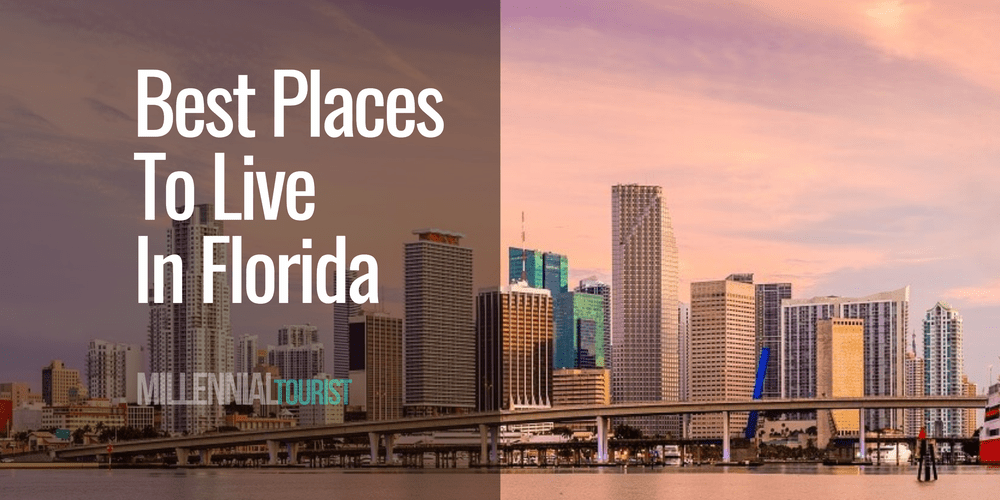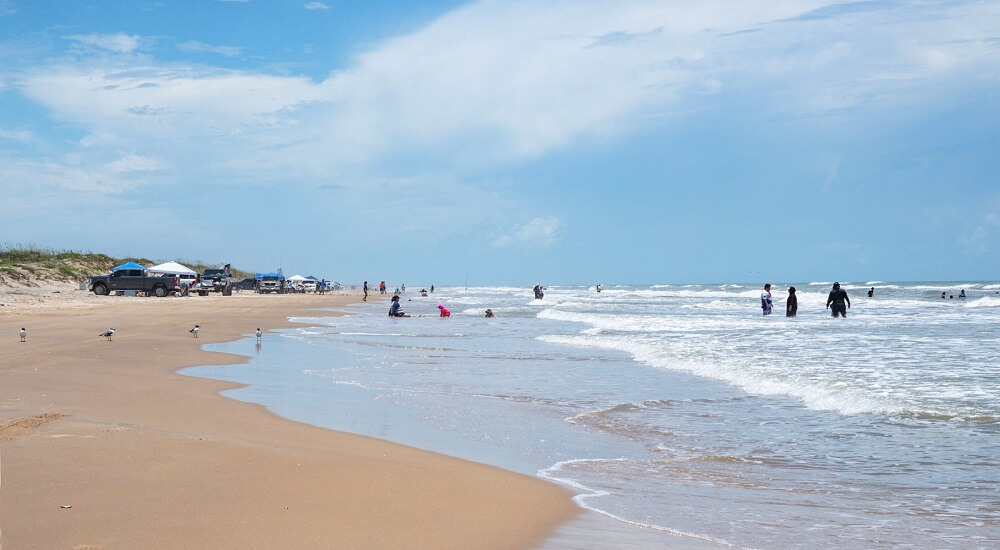A trip to Banff or Jasper National Park is not complete without visiting Athabasca Falls. This major attraction is located in Jasper National Park in the Canadian Rockies. It is a must-see for anyone exploring the area.
Athabasca Falls in Jasper is easily accessible, making it a perfect stop for families and adventurers. The falls are fed by the powerful Athabasca River and melting snow, creating a stunning and unforgettable sight.
With its breathtaking scenery and rich natural beauty, Athabasca Falls is a highlight that should be on everyone’s itinerary when visiting Jasper National Park.
About Athabasca Falls
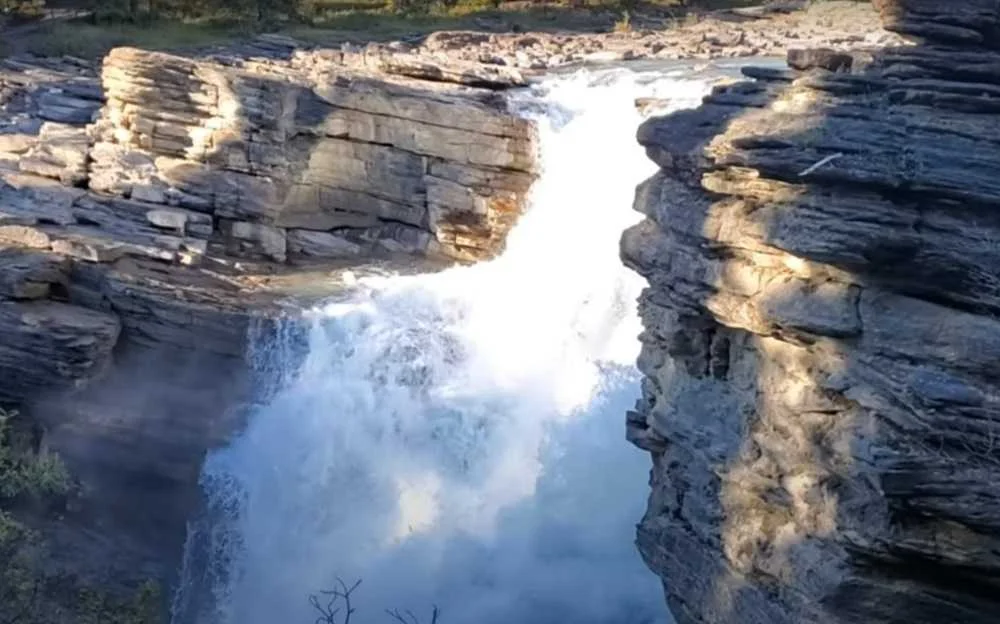
Athabasca Falls in Alberta is a stunning sight in Jasper National Park. It’s not the tallest waterfall in Alberta, but it’s famous for its powerful flow. The falls, a Class 5 waterfall, were created by the last glaciation’s work.
Athabasca Falls is located just minutes south of Jasper town, in addition, Athabasca Falls is one of the best stops on the Icefields Parkway. Known for its powerful flow, the falls are fed by the Athabasca River, which carves through the rugged landscape with stunning force.
Visitors can experience the breathtaking views from various viewpoints, providing unique perspectives of the cascading water and the surrounding canyon.
Athabasca Falls is not only one of the most powerful waterfalls in the Canadian Rockies, but it also offers an educational and scenic experience. The well-maintained paths and informative signs make it easy for visitors of all ages to explore and learn about the natural beauty and geological history of the area.
History and Formation of Athabasca Falls
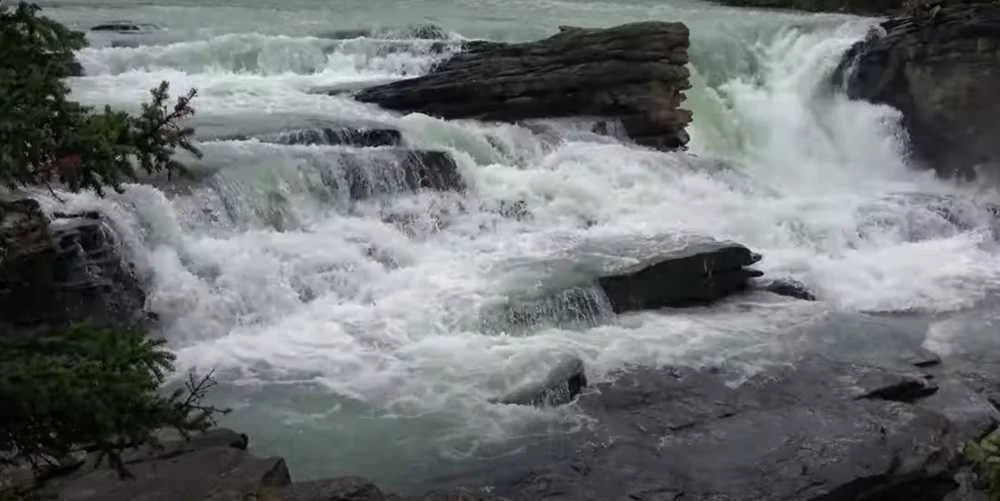
Athabasca Falls is a key landmark in the Canadian Rockies’ history. It’s located at 52°39′51″N 117°53′01″W. The falls are 24 meters high and have two main drops. The longer drop is 20 meters. Athabasca Falls is 46 meters wide. This shows the Athabasca River’s natural power and beauty.
The story of Athabasca Falls goes back to the last ice age. Back then, the Athabasca Valley Glacier shaped much of the area. It cut through the land, removing huge pieces of quartzite. When the glacier retreated, the Athabasca River started to erode the land. It flowed over quartzite cliffs and limestone canyons.
This history led to the unique landscape we see today. The Athabasca River goes over quartzite cliffs. It keeps wearing down the limestone canyon walls. The glacier activity and erosion created potholes and patterns in the canyon. Sand and gravel from the river flow also shaped these. This shows nature’s creativity. It gives us interesting facts about Athabasca Falls.
Athabasca Falls is seen as a Class 5 waterfall. This means it has a powerful and dramatic flow. The flow rate is around 113 m3/s. This shows the Athabasca River’s strong force. These forces keep changing the landscape. This makes Athabasca Falls a constantly evolving sight in Jasper National Park.
How to Get to Athabasca Falls
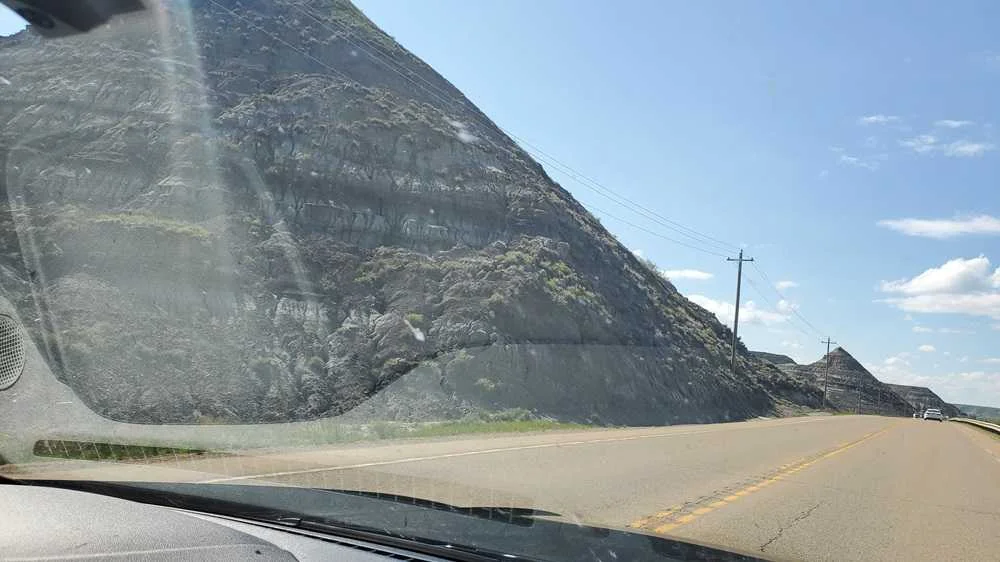
Getting to Athabasca Falls in Jasper National Park is easy and rewarding. It’s about 32 km southeast of Jasper town. This beautiful waterfall is reachable by car for all visitors.
Directions from Jasper to Athabasca Falls
Start by heading south from Jasper on Highway 93, the Icefields Parkway. This road is known for its amazing views and is a highlight when going to the falls. After driving for about 25 minutes, look for the marked turn-off for the falls on Highway 93A. Signs make it easy to find the way to the Athabasca Falls trailhead.
Continue on this path until you see a parking lot near the falls. This makes visiting the falls convenient.
Using GPS and Maps
Using GPS is very helpful in Jasper National Park, where service can be spotty. Make sure to download maps or set your destination before your trip to Alberta. Having the right directions helps avoid any trouble on your trip.
Even if service cuts out, GPS and clear signs make finding Athabasca Falls easy. This ensures a straightforward trip to this wonderful spot.
Athabasca Falls directions from Banff
To get to Athabasca Falls from Banff, start by heading north on the Trans-Canada Highway (Highway 1). Continue on this route until you reach Lake Louise, where you’ll merge onto the Icefields Parkway (Highway 93N). This scenic drive will take you through some of the most breathtaking landscapes in the Canadian Rockies, including views of towering mountains and pristine lakes.
As you drive along the Icefields Parkway, you’ll pass through Banff National Park and into Jasper National Park, the largest national park in the Canadian Rockies. Continue north for approximately 200 kilometers, following the signs for Jasper. Athabasca Falls is located just minutes south of the town of Jasper. Watch for signs indicating the turnoff to the falls, and take the exit onto the access road leading to the parking area.
Once you’ve parked, you’ll find a well-marked trail along the falls, allowing you to explore various viewpoints and enjoy the stunning scenery. The drive from Banff to Athabasca Falls typically takes about 3.5 to 4 hours, making it a perfect day trip for those looking to experience one of the most powerful and beautiful waterfalls in the region.
Best Time to Visit Athabasca Falls
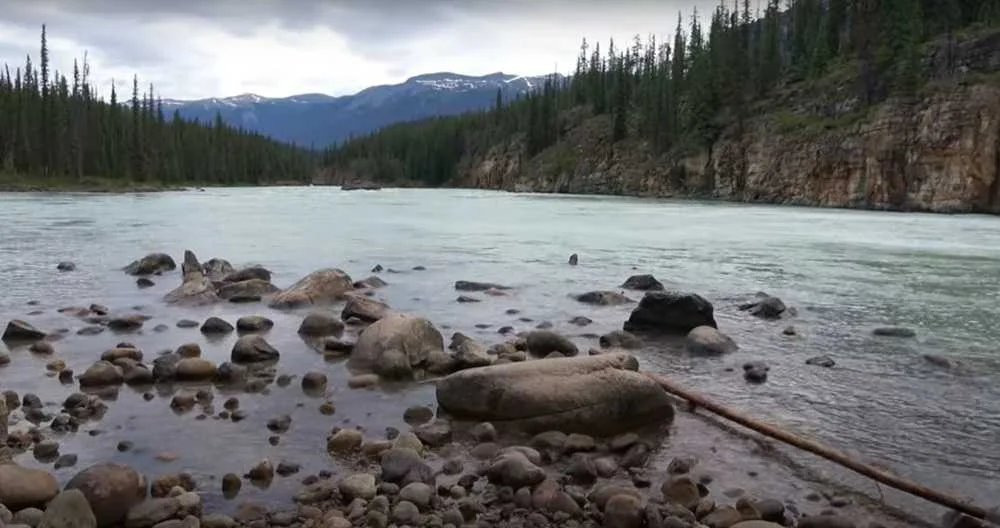
Athabasca Falls, a crowning jewel of the Canadian Rockies, is always a breathtaking sight. Still, the time of year you go can change your experience a lot.
Spring and Summer
Visiting Athabasca Falls in late spring and early summer is amazing. This is when melting snow makes the river roar as it drops 23 meters down into the canyon. In spring, you’ll find fewer people and have a peaceful time enjoying the view.
During summer, the falls get busier as visitors flock from everywhere. To avoid crowds, go early in the morning or late in the afternoon. The views are stunning in summer, and there’s plenty of parking, making the trip worth it.
Athabasca Falls in winter
In winter, Athabasca Falls turns into a quiet, frozen wonder. It’s surrounded by snow-covered trees and ice. The trail is short and easy, so it’s a great spot to visit in the colder months. You’ll find it less crowded, perfect for taking photos and enjoying the silence.
Every season at Athabasca Falls offers something special. Whether you’re after the majestic flows of spring and summer or the calm ice of winter, it won’t disappoint. Remember these travel tips for a great visit to the Canadian Rockies, no matter when you decide to go.
What to expect when you visit this waterfall

When visiting Athabasca Falls, you can expect an unforgettable experience. Athabasca Falls is probably one of the most powerful waterfalls in the Canadian Rockies. The falls are known for their strong flow, especially during spring and early summer when the snow melts. The sound of the rushing water is both thrilling and calming, creating a perfect atmosphere for nature lovers.
The area around the falls is just as impressive. You’ll find well-maintained paths that lead to various viewpoints, each offering a different perspective of the falls. The viewing platforms provide safe and stunning spots to take photos and admire the waterfall’s beauty.
As you explore, you’ll notice the unique rock formations shaped by the force of the water over thousands of years. The turquoise water of the Athabasca River adds to the breathtaking scenery. Besides the main attraction, the surrounding forest and canyon offer plenty of opportunities for hiking and wildlife spotting.
Read Also: Cave And Basin National Historic Site
Athabasca Falls Trail and Viewpoints
The Athabasca Falls Trail is perfect for nature lovers. It stretches roughly 1 km and isn’t steep, rising only 15-20 meters. It’s known as an easy trail in Alberta, welcoming hikers of every level. You just need regular running shoes to walk this trail.
Walking the trail, you’ll see many Athabasca Falls viewpoints. These spots give you stunning views of the falls and canyon. Look for erosion lines, potholes, and cool shapes made by the Athabasca River. The Athabasca Falls bridge lets you see the river and Mount Kerkeslin. It’s among the best hiking trails in Jasper.
The site has things like outhouses and places to eat outside. This makes it easy to stay and explore longer. In the winter, the falls freeze over. It’s a sight to see and less busy than in summer.
If you love hiking or just a simple stroll, the Jasper National Park hiking at Athabasca Falls is great. The paths are clear and invite you to take your time. Look at every beautiful thing there. Visit early morning or late afternoon in summer to miss the crowds.
Athabasca Falls is a top spot on any scenic hiking in Canada list. The easy, flat walk lets everyone enjoy Alberta’s beauty. You’ll see the amazing waterfall and fascinating geological features of the gorge.
Safety Tips and Visitor Guidelines

Keeping safe at Athabasca Falls is key because the waterfall’s power is immense, standing at 23 meters. Visitors must follow all visitor guidelines. Stay back from the edge by keeping behind the safety railings and fences. These barriers help keep you safe from the slippery edges near the canyon and river.
To protect the park’s beauty, it’s vital to follow Alberta’s nature preservation rules. Stick to leave no trace principles. Always take your trash with you. This keeps the environment clean. Everyone visiting Jasper plays a role in keeping wildlife safe and preserving their natural home.
While exploring, keep in mind that you’re in bear territory. Heed all bear country precautions. Don’t leave food out and store your snacks correctly. Being alert helps protect you and the animals that live there.
Walking the Athabasca Falls Trail is an adventure. This 1 km loop has a gentle elevation change. Regular sneakers are usually fine for this hike. But, be ready for changing weather conditions in Jasper National Park. The trail starts at the parking lot, making for an easy and safe walk any time of the year.
Being a responsible tourist in Jasper means making smart decisions, especially about hiking safety. Enjoy the stunning views carefully and respectfully. Doing so will help make your visit to Athabasca Falls safe and memorable.
Visitor Facilities

Athabasca Falls offers a range of visitor facilities to ensure a comfortable and enjoyable visit. There is a spacious parking area located conveniently close to the falls, making it easy to access. Clean restrooms are available near the parking lot, providing necessary amenities for all visitors. For those looking to enjoy a meal amidst the stunning scenery, designated picnic areas are provided, complete with tables and benches.
Accessibility is also a priority at Athabasca Falls. The paths leading to the viewpoints are well-maintained and include sections that are wheelchair-friendly, allowing everyone to experience the beauty of the falls up close.
Where to stay when you visit Athabasca Falls
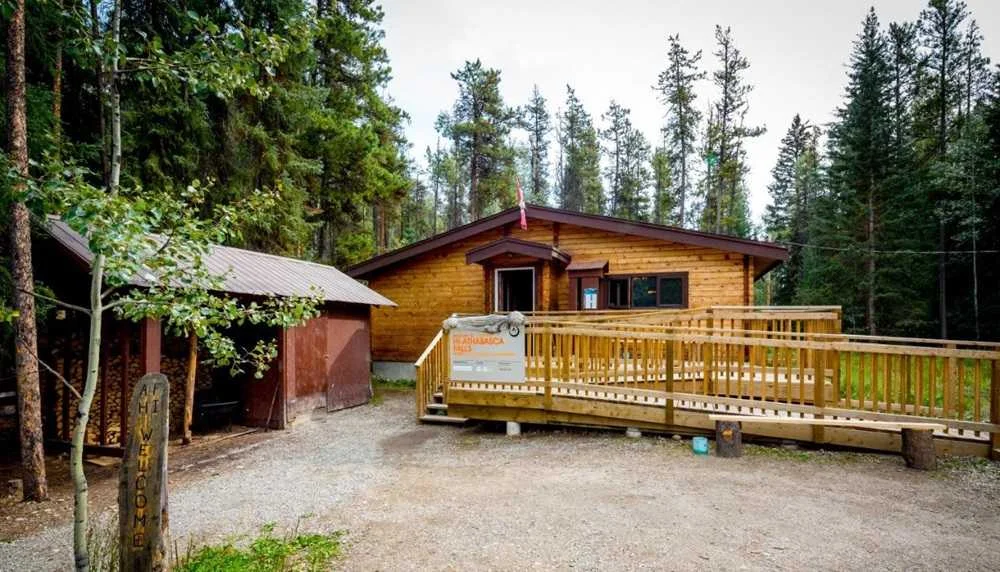
When planning a trip to Athabasca Falls, consider booking a Jasper National Park hotel. These hotels offer easy access to the falls and other major spots. You’ll find everything from luxury resorts to cozy cabins, matching all tastes and budgets.
The HI Athabasca Falls Wilderness Hostel is a great pick for a special stay. It’s close to the falls and has green features like solar power and mountain well water. There’s no running water, but you get clean drinking water, electricity, and free WIFI. Plus, there’s a kitchen, free parking, and lots of space for groups.
Another excellent option is the HI Jasper Hostel, located within the town of Jasper. It offers modern amenities, free wifi, and easy access to restaurants and shops, making it a convenient base for exploring the area.
For those seeking a more luxurious experience, the Fairmont Jasper Park Lodge provides a range of upscale accommodations with beautiful views, fine dining, and various recreational activities.
Looking further, Alberta’s Icefields Parkway has more fabulous stay options. This famous road boasts many Jasper stays and lodges in the Canadian Rockies, from cheap motels to fancy lodges. Choosing Jasper means you’re all set to see the park’s many sights without hassle.
Flora and Fauna around Athabasca Falls
Athabasca Falls may be known for its rapid and powerful flow of water, but the surrounding flora and fauna add another dimension to this stunning natural attraction. As visitors cross the bridge over the sheer volume of water rushing through the beautiful canyon, they can spot various plants and animals indigenous to the area.
Mount Edith Cavell looms in the background, with towering mountains surrounding the falls. You can also stretch your legs by taking a hike to Maligne Lake or Johnston Canyon, both of which offer opportunities to see more of the flora and fauna in the area.
The hard quartzite rock formations provide a striking contrast to the lush greenery, making this a photographer’s dream. Don’t forget to book tickets for a shuttle to another viewpoint at the end of the canyon for a truly breathtaking perspective.
Local Wildlife
Around Athabasca Falls, you might see bears, elk, squirrels, and various birds. The area teems with Alberta wildlife. With the Rocky Mountains around, it’s perfect for wildlife watching. Every visit brings something new and thrilling.
Plant Life
The greenery around Athabasca Falls adds to its charm. You’ll find tall trees, bright wildflowers, and tough shrubs, all adapted to Jasper’s climate. It’s vital to keep these ecosystems healthy. Staying on the trails protects this beautiful nature. Exploring, whether it’s a short 1 km hike to the falls or deeper into the park, is always inspiring.
Photography Tips for Athabasca Falls
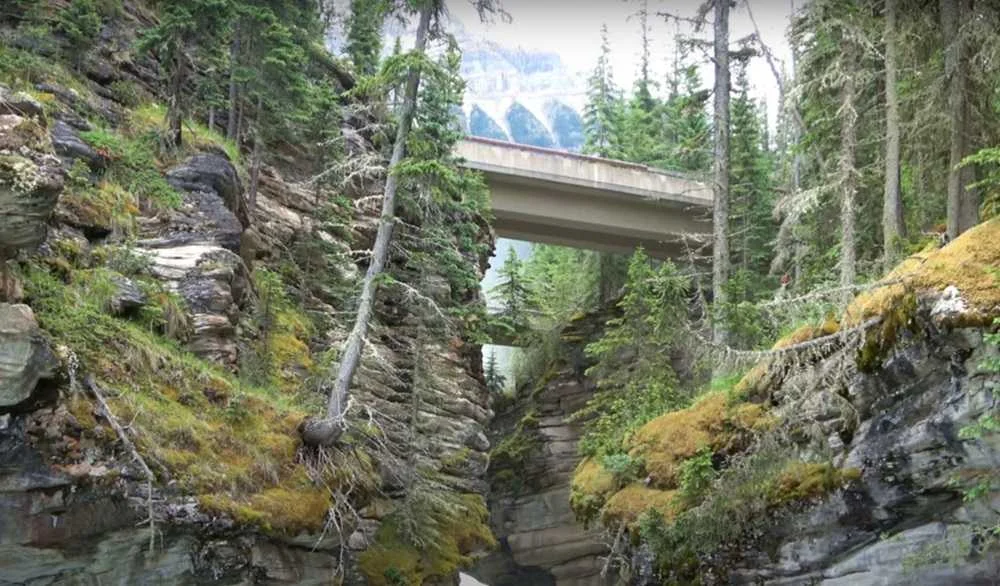
Athabasca Falls is a top spot for waterfall photos on the Icefields Parkway. It’s very popular, so visit in the early morning or late afternoon to dodge the crowds. To get the best shots, play with your camera settings. Using a tripod can really help, especially for long-exposure shots that make the water look smooth.
Try changing shutter speeds to get different looks for the water flow. Use neutral density filters for long exposures, like ISO 100 and f/22. The golden hours of dawn and dusk give the best light, making the falls look amazing.
If you want great photos in Jasper National Park, the weather matters a lot. Bring gear that can handle rain, like a waterproof camera and sturdy shoes. The Arc’teryx Konseal FL 2 approach shoes are a good choice. This way, you’re ready for any weather and can capture the fall’s beauty.
Athabasca Falls isn’t just about the waterfall. The rocks around it offer many views for your photos. Check the weather before you go to pack right. With these tips, you’ll take home amazing pictures of Athabasca Falls and its stunning scenery.
Nearby Attractions and Activities
Athabasca Falls is amazing with its 23-meter drop. It’s just one of the wonders on the Icefields Parkway. This road offers stunning views and many adventures, making a visit to Jasper National Park unforgettable.
Sunwapta Falls
Sunwapta Falls is not far, just 56 km from Jasper and 177 km from Lake Louise. It has upper and lower falls that offer peaceful views. Fed by the Sunwapta River, this place shows the power of nature. It’s a great spot for seeing Alberta’s sights and the Canadian Rockies.
Icefields Parkway
The Icefields Parkway is a road trip dream. It goes from Lake Louise to Jasper, through the Canadian Rockies. There are many things to do like hiking, glacier tours, and seeing wildlife. You also get to see beautiful lakes like Peyto and Bow Lake, making your time outdoors in Jasper amazing.
You can’t miss out on driving the Icefields Parkway. See the huge Columbia Icefield and enjoy the quiet at Saskatchewan River Crossing. Every stop, from Sunwapta Falls to the Weeping Wall, is worth it. This road will make your trip unforgettable.
Conclusion: Athabasca Waterfall in Alberta
Visiting Athabasca Falls is a key part of your Jasper adventure. Each viewpoint shows the waterfall’s might and the area’s beauty. Despite the crowds, it remains a must-see for visitors.
The journey doesn’t stop at Athabasca Falls. With the next gas station 150 miles away at Lake Louise Village, plan carefully. The stunning Icefields Parkway and hikes like the one to Lower Sunwapta Falls provide a full experience for nature lovers.
The tour of Athabasca Falls highlights environmental issues. Since the 1800s, the Athabasca Glacier has shrunk by 1.75 kilometers. This melting, along with high greenhouse gas emissions, highlights the threat to Alberta’s nature and global environmental challenges.
In closing thoughts on Alberta, Athabasca Falls symbolizes more than beauty. It’s where natural beauty meets our duty to the environment. Visiting offers a powerful mix of amazing views and a reminder of the need to protect our planet.
FAQs about Athabasca Falls, Jasper National Park
What is Athabasca Falls?
Athabasca Falls is a stunning waterfall located in Jasper National Park in Alberta, Canada. It is formed by the Athabasca River and is a popular tourist attraction in the Canadian Rockies region.
How do I get to Athabasca Falls?
To visit Athabasca Falls, you can drive along the Icefields Parkway (Highway 93) south of Jasper town in Jasper National Park.
What can I expect when visiting Athabasca Falls?
When you visit Athabasca Falls in Jasper, you will witness the magnificent flow of the Athabasca River cascading down the canyon and creating a beautiful waterfall amidst the glacier-carved landscape.
When is the best time to visit Athabasca Falls?
The best time to visit Athabasca Falls is during the summer months, when the volume of water is higher, providing a more spectacular sight. However, it is accessible year-round.
Are there any activities to do around Athabasca Falls?
Around Athabasca Falls, you can enjoy hiking trails, and viewing platforms, and even engage in whitewater rafting on the mighty Athabasca River for an adventurous experience.
What is the significance of the Athabasca Falls in Jasper National Park?
Athabasca Falls is one of the iconic landmarks in Jasper National Park that showcases the remarkable power of nature.
How long of a hike is Athabasca Falls?
Athabasca Falls is not a long hike; it’s a short, easy walk from the parking area to various viewpoints around the falls.
Is Athabasca Falls worth seeing?
Yes, Athabasca Falls is definitely worth seeing for its powerful flow and stunning natural beauty.
Do you have to pay to go to Athabasca Falls?
There is no specific fee to visit Athabasca Falls, but you need to pay for a park pass to enter Jasper National Park.
